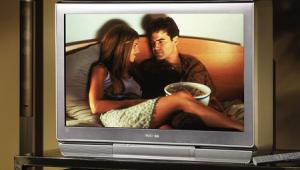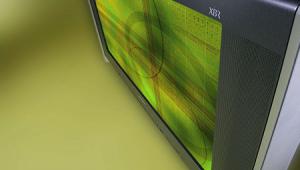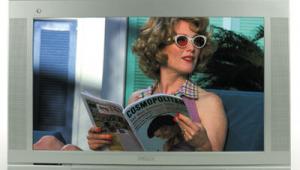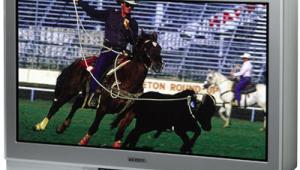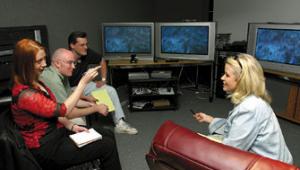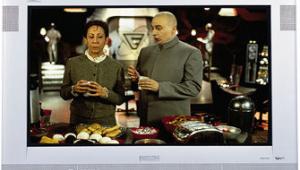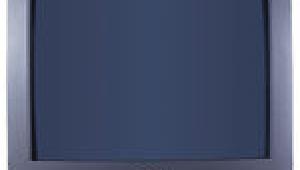RCA D34W20 direct-view high-definition monitor
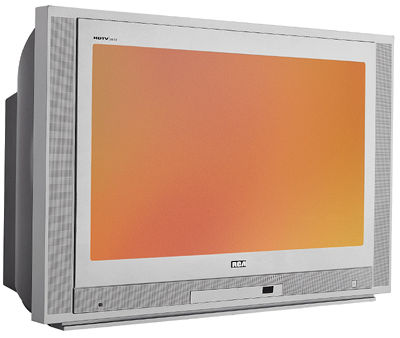
When the time came for color television, RCA unambiguously created and commercialized it. Then, in the 1990s, RCA's research arm, which had been spun off as Sarnoff Labs, was among the groups that created the digital, high-definition TV system now being slowly introduced nationwide. No company has been more inextricably linked to television than RCA.
Now, of course, RCA is simply a brand name, one of several used by Thomson Multimedia Inc., the French firm that bought RCA from General Electric in the 1980s. Thomson has remained an unabashed promoter of HDTV, and this new model, the D34W20, is a fine example: a 34-inch, 16:9 set at the competitive price of $2399. It comes complete with one of the new digital inputs—DVI with HDCP copy protection—that soon will be needed to receive certain HD broadcasts, including those from DirecTV.
Among cognoscenti, the more flexible and generally preferred digital input is IEEE 1394, or FireWire. Theoretically, FireWire permits recording of HD programming, if the copy-protection codes associated with the broadcast permit it. FireWire also allows interconnection of components, as Mitsubishi offers with its HDTVs. But that input is much more expensive to include, and Thomson offers it only in their more expensive sets, the ones with integrated DTV receivers. (The D34W20 is a digital monitor; a digital tuner is required for watching HDTV.)
The D34W20 also had two wideband component inputs—a nice, even necessary feature these days that too many manufacturers omit. Either one can accommodate a digital tuner or a progressive-scan DVD player. Interestingly, there is no VGA input for use with the company's older DTC-100 satellite receiver box. Another set of audio, composite, and S-video inputs is situated on a panel on the left side of the cabinet, conveniently out of sight so as not to mar the front panel's appearance.
The cabinet is a dull silver, like most new TVs. The speaker grilles wrap around it, and another round speaker grille, for a small woofer, sticks up from the left rear top of the cabinet. There are also speaker outputs for an external subwoofer, but that would have to be a modest unit—the onboard amplifier offers only 18W of power. All in all, the D34W20 provides better built-in sound than many TVs, though connecting it to an outboard sound system would obviously be preferable.
The screen is perfectly flat, and the D34W20, like nearly all DTVs, has an onboard scaler that converts conventional NTSC signals to progressive scan. You can choose an optional faceplate in one of several colors—plum, onyx, graphite, etc.—to match the set to your room décor, for an additional $19.99-$29.99, depending on color. In any case, these faceplates are actually frames; even when one is installed, most of the faceplate will still be silver. A custom-fit stand with two glass shelves costs $349.
The D34W20 is similar in almost every respect to Thomson's Scenium D34W135D model. Scenium is Thomson's new premium line, long promised and just recently come to market. The Scenium version, at $2599, offers several features that many buyers might consider well worth the extra $200. It has a built-in DVD player, a feature of questionable value—anyone buying a DTV probably already owns a player. [Ponder, too, the possibility that if the DVD player ever needs repair, you may have to haul the whole 170-pound kaboodle to the service center, and be without the TV in the interim.—TJN] Still, there may be some people who will want to use the Scenium in a bedroom, or without an accompanying home-theater system, and they'll enjoy the convenience. The most important difference is that the Scenium version offers 3:2 pulldown correction for film-based DVD material, which removes jagged-line artifacts. The D34W20 lacks this feature—a not-insignificant failing.
The remote is a standard RCA model, with backlighting for a few key buttons. I've never been a fan of this remote and others like it, which have two similar button rings: one for menu navigation, the other for volume and channel changing—a confusing arrangement. In any case, the remote is programmable and works as it should. However, the single input button forces you to scroll through all of the inputs to get to the one you want, which is a real bother.
The two buttons labeled Zoom on the lower ring run through seven different aspect-ratio options, including a superb stretch function for watching 4:3 shows on this widescreen set: The edges of the screen, where less critical content is usually shown, are stretched more than the center. All in all, these Zoom functions are among the best I've seen. Buyers may appreciate them—otherwise, a 4:3 picture displayed on the D34W20 is actually rather small.
The D34W20 also provides individual picture-setting functions for each input, another excellent feature. For example, HDTV requires settings wholly different from NTSC, particularly for color and brightness.
